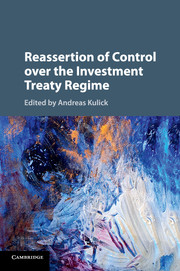Book contents
- Frontmatter
- Contents
- List of Contributors
- Preface
- PART I Introduction, Theory and Domestic Law Approaches
- PART II Procedural Aspects and Avenues of Reassertion
- PART III Substantive Aspects and Avenues of Reassertion
- 7 Masters of Puppets? Reassertion of Control through Joint Investment Treaty Interpretation
- 8 Systemic Integration: An Instrument for Reasserting the State's Control in Investment Arbitration?
- 9 Reasserting Control through Withdrawal from Investment Agreements: What Role for the Law of Treaties?
- 10 Legitimate Regulatory Interests: Case Law and Developments in IIA Practice
- 11 State Controls over Available Remedies in Investor-State Arbitration
- PART IV Reassertion of Control: Policy and Trends
- Index
7 - Masters of Puppets? Reassertion of Control through Joint Investment Treaty Interpretation
from PART III - Substantive Aspects and Avenues of Reassertion
Published online by Cambridge University Press: 12 January 2017
- Frontmatter
- Contents
- List of Contributors
- Preface
- PART I Introduction, Theory and Domestic Law Approaches
- PART II Procedural Aspects and Avenues of Reassertion
- PART III Substantive Aspects and Avenues of Reassertion
- 7 Masters of Puppets? Reassertion of Control through Joint Investment Treaty Interpretation
- 8 Systemic Integration: An Instrument for Reasserting the State's Control in Investment Arbitration?
- 9 Reasserting Control through Withdrawal from Investment Agreements: What Role for the Law of Treaties?
- 10 Legitimate Regulatory Interests: Case Law and Developments in IIA Practice
- 11 State Controls over Available Remedies in Investor-State Arbitration
- PART IV Reassertion of Control: Policy and Trends
- Index
Summary
A. Introduction
The explosion of international investment arbitration under international investment agreements (IIAs), whether bilateral or multilateral, in the last two decades has given birth to a new and purportedly distinct ‘specialisation’ in international law, that of international investment law. But it also eventually caused a significant ‘backlash’ against investment arbitration and IIAs in general. This has led not solely to a new generation of IIAs but also to a movement towards the reassertion of control over the operation of ‘previous generations’ of IIAs by their States parties. This reassertion of control is the attempt of States parties to IIAs to wrestle back control over their international obligations and regulatory authority from what they see as investment tribunals occasionally running amok.
The reasons for States parties seeking to reassert control over their IIAs may in part lie in the fact that States had not really realised what they were getting themselves into when they negotiated and concluded many of these agreements. The drafters of the agreements were not necessarily aware at the time of the implications that the structure and language of the treaty provisions would have in practice. Indeed, many States were rushed into signing template agreements with little negotiation or advice, the Attorney-General of Ecuador admitting that it was as much akin to an accession contract as signing an agreement to be issued a credit card. This may indeed explain the ‘remarkable uniformity of language’ used in many IIAs.
Nor could the States have foreseen that the ‘practice’ would be a burgeoning practice of investment arbitration, now occupying most of the time of major public international law firms and practitioners, pouring over the mostly vague clauses in the IIAs. Only recently, and mainly during the current century, has there been enough jurisprudence on investment disputes for States to realise in what far-reaching manner some of the provisions they agreed to could be construed as a result of the ‘combination of imprecise, ambiguous standards and ad hoc arbitral resolution’. And indeed it is quite curious that it is arbitral jurisprudence (with each tribunal becoming functus officio and dissolving into thin air after each case) that has come to dominate the interpretative process in international investment law.
- Type
- Chapter
- Information
- Reassertion of Control over the Investment Treaty Regime , pp. 155 - 181Publisher: Cambridge University PressPrint publication year: 2016
- 7
- Cited by

